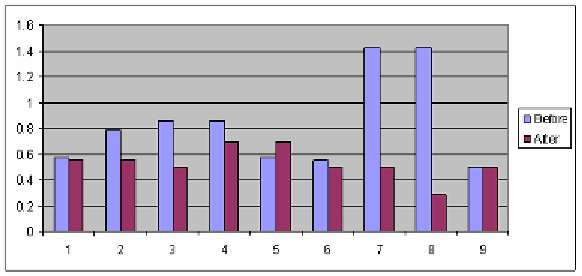Information Technology Reference
In-Depth Information
Q7.
creating a lesson based on lessons
created by other authors?
New issues:
Q8.
adding collaborative authoring (i.e.
tagging, rating, commenting on con-
tent)?
Q9.
adding authoring for collaboration (i.e.
defining groups of authors, subscribing
to other authors)?
ing, keyword access, copying, linking of concepts,
lesson creation and reuse, and collaborative au-
thoring). Moreover, the variance for most of these
questions is less for the new system, showing a
higher level of agreement between testers. The
mean is very slightly higher for the first question
for the first system. Looking at the qualitative
comments, the only criticism is about the domain
maps not being in alphabetical order. In the follow-
up implementations, we have already introduced
various ways of ordering the domain maps beside
the default ones (which are based on the order of
creation).
More worrisome for the MOT 2.0 imple-
mentation is the fact that Q9 on authoring for
collaboration was scored lower, suggesting that
at least some of the expectations of the design-
ers had not been fulfilled. One designer who had
given it a score of 3 was complaining about the
rights related to these groups and the exact pro-
cedure for forming them. In the version we had
given them to test, groups were pre-formed and
joining and leaving groups was open to all. An
administrator role is necessary for allowing for
group formation, since people could otherwise be
inviting others into their own groups, as well as
restricting unwanted persons from joining their
groups. Such functionality is clearly desirable and
has been taken into consideration in the follow-up
developments.
Note that questions 1-7 are general function-
ality questions. This functionality was present in
both systems, but there were changes (we were
trying to find out if they were improvements) in
MOT 2.0. Questions 8 and 9 address collaboration
functionality - MOT 2.0 had this functionality
implemented, whereas MOT 1.0 did not have it.
Thus, the question was kept generic, in order to
refer to future extensions, in the case of MOT 1.0,
and to actual implemented features, in MOT 2.0.
Figure 9 shows the mean response of the au-
thors (the Softwin designers) for the two systems,
whilst Figure 10 shows the variance. Due to the
small number of designers used in this study, we
cannot speak directly about statistical significance.
Instead, we can observe the general preferences.
Overall, both systems scored above the expected
average of 2.5 (in fact, they scored above 3).
There is a slight preference for the functional-
ity of the new system in all aspects (lesson brows-
Figure 10. The variance before (MOT 1.0) and after (MOT 2.0) by the authors

Search WWH ::

Custom Search